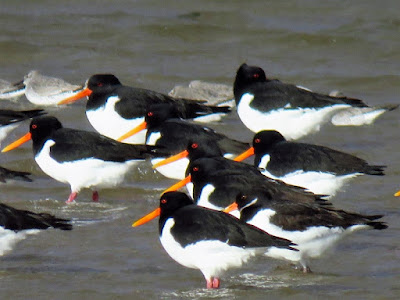A single Shelduck was present when I arrived but flew off. Here he goes – a 'he' because of the wide chest-band and the very prominent red shield at the base of the bill.
A group of Shoveler in flight. Four drakes and a duck. The lower middle drake shows some white behind the bill indicating it is a first year bird.
In close up a drake going this way...
...and that.
And a duck Shoveler. She needs to be camouflaged while she is sitting on the nest incubating the eggs. The bill is an amazing adaptation for filtering small food items out of the water.
A flotilla of Pochard comprising four drake and two ducks (one of the drakes is almost obscured by the second duck. A Great Crested Grebe looks on.
Very smart. The of the two Great Crested Grebes present.
The Little Egret comes in to land showing its yellow feet.
It is always good to see plenty of Lapwings these days. They are difficult to photograph in flight as their loose flocks are typically haphazardly arranged. This group managed to sort themselves out.
This one was reasonably close and catching the afternoon sun.
One coming in to land to join another.
Lapwings are very jumpy. This passing Common Buzzard put them all up.
At the woodland hide there are a few natural perches. A Blue Tit of course.
Here looking to see where there is available space on the feeders. Note the rather gnarled feet. It does not look as if it caused by the fungus that is particularly seen in Chaffinches. Old age?
This one seeking inspiration.
"no publicity please"
A Great Tit.
This one is a male – the wide parallel-sized 'zip' down the belly is the diagnostic feature. Not sure why the head looks so flat-topped.






























